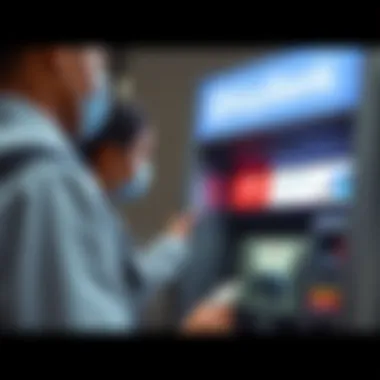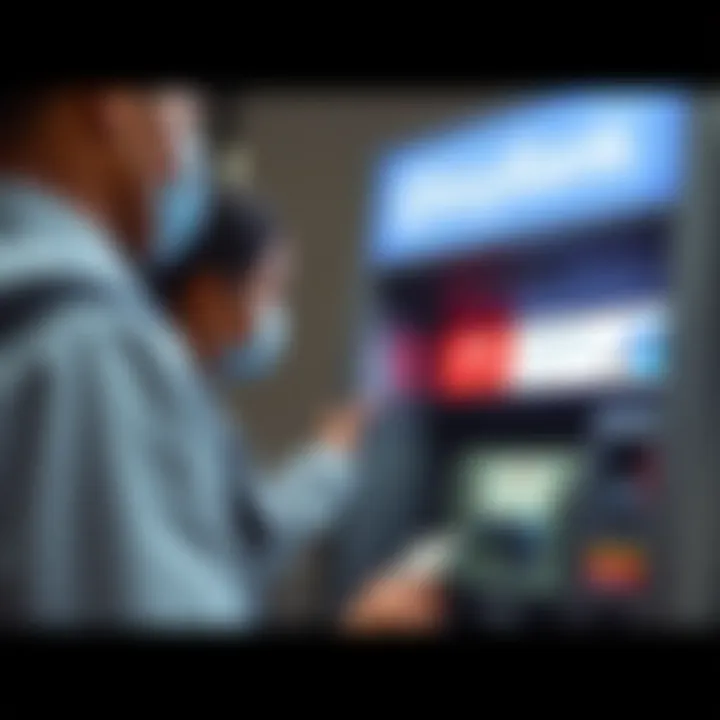Explore KeyBank ATM Cash Deposit Functions


Intro
In today’s fast-paced financial landscape, understanding how to efficiently utilize ATM technology is more crucial than ever. KeyBank’s ATM cash deposit functions offer a streamlined way to handle cash transactions, catering to the diverse needs of customers who seek convenience and efficiency in banking.
As we transition deeper into a cashless society, the significance of functional ATMs cannot be overstated. This examination reveals not only the operational usability of KeyBank ATMs, but also unpacks the various layers of security, user guidelines, and the overall impact of these services on modern banking behaviors. The following sections delve into crucial insights pertaining to cash deposit functionalities, providing a clear lens through which to view KeyBank’s role in evolving financial practices.
Preamble to KeyBank ATM Cash Deposits
In an age where digital currency seems to dominate, ATM cash deposits remain a constant in banking. KeyBank, a significant player in the banking sector, has tailored its services to meet these needs effectively. Understanding the functions and processes behind its ATM cash deposit system is crucial for both seasoned investors and everyday consumers.
KeyBank stands out not just for its comprehensive banking services, but for how these services align with modern financial behaviors. As everything shifts towards convenience, ATMs become pivotal. They provide an avenue where customers can engage in cash transactions quickly. Those looking to deposit cash can do so without having to step into a bank branch, valuable especially during times of uncertainty.
One key consideration is the potential for operational advantages. For example, the availability of ATMs means that cash deposits can occur 24/7, accommodating a variety of schedules. This flexibility introduces increased efficiency in personal banking and guarantees that funds can often be made available to account holders without delay.
Lastly, the importance of technological integration cannot be overstated. KeyBank's ATM systems are designed to ensure that user experience is top-notch. This provides a meaningful layer of security while simultaneously ensuring ease of access, a balance that is vital in today’s financial landscape.
"In the realm of modern banking, understanding how to effectively use ATM services can save time, enhance convenience, and ultimately translate to better financial management."
By diving deeper into what makes KeyBank’s ATM cash deposit function robust, users will unlock insights into how these practical tools align with broader technological trends and make their banking experience smoother overall.
Operational Framework
Understanding the operational framework of KeyBank ATM cash deposit functions is paramount for users wishing to make the most of their banking experience. This framework encapsulates the processes, technologies, and user interactions involved in facilitating cash deposits via ATMs. By grasping this operational landscape, users can navigate through their transactions with confidence and efficiency. Moreover, a solid awareness of how these functions operate can maximize benefits, minimize errors, and enhance overall user satisfaction.
How Cash Deposits Work
Using KeyBank ATMs for cash deposits is a straightforward process designed with the user in mind. To start, users must locate an appropriate ATM equipped for cash deposits. A simple search on the KeyBank website or mobile app can reveal nearby options. Upon arriving at the ATM, the user must insert their debit or ATM card, which prompts the system to verify their identity through a Personal Identification Number (PIN).
Once the user is authenticated, they are presented with various transaction options. Selecting the cash deposit option guides them through the next steps. Here’s how it unfolds:
- Insertion of Cash: The user is prompted to insert the cash into the designated slot. Unlike traditional deposits, ATMs are generally capable of handling multiple bills at once, provided they are in decent condition.
- Counting and Verification: The ATM counts and verifies the bills. A notice on the screen will indicate if any bills are torn, crumpled, or unrecognized, requesting the user either to remove those or replace them.
- Confirmation: After the counting process, the ATM displays the total amount deposited and asks for confirmation. Users should always take a moment to double-check this information, ensuring it aligns with their records.
- Receipt Option: Following confirmation, the user can opt to print a receipt, which serves as proof of the transaction. Keeping a record of this is a good practice to reconcile at a later date.
This system ensures efficiency and security, minimizing the need for in-person interactions while streamlining the deposit process.
Types of Acceptable Deposits
In utilizing KeyBank ATMs for cash deposits, users should be aware of what types of cash transactions are accepted. Generally, the ATMs accept:
- Personal Cash Deposits: Standard currency that individuals deposit into their own accounts, whether personal or joint accounts.
- Business Cash Deposits: Small businesses frequently use ATMs for quick deposits of cash receipts, providing an efficient alternative to bank branches.
- Currency Format: These ATMs accept U.S. bills; however, they cannot accept coins, checks, or foreign currency. This limitation reflects current banking practices and simplifies the transaction process.
While the convenience of ATM cash deposits is significant, users should follow the guidelines laid out by KeyBank. Awareness of these categories ensures clarity in transactions, allowing customers to utilize the ATM with peace of mind.
"Being prepared and knowing the rules can turn a complex chore into a breeze, especially with something as straightforward as cash deposits at an ATM."
User Experience
Understanding the user experience with KeyBank ATM cash deposits is crucial for enhancing both customer satisfaction and operational efficiency. A seamless interaction leads to reduced transaction times and minimizes user error, which can be a source of frustration. This section dives into the essential elements that shape the user experience, focusing on the specific benefits and considerations that users encounter when utilizing KeyBank’s ATM cash deposit functions.
Step-by-Step Guide to Making a Deposit
Navigating the ATM to make a cash deposit need not feel like rocket science. Here’s a simple breakdown of the process that users can follow:


- Locate the KeyBank ATM: Start by finding the nearest KeyBank ATM that supports cash deposits. This can usually be done through the KeyBank mobile app or their website.
- Insert your Card: Once at the ATM, insert your KeyBank debit or ATM card. Make sure to place it in the slot as indicated, with the magnetic stripe facing the machine.
- Enter your PIN: After the card is read, input your Personal Identification Number (PIN) to access your account. This step is crucial for ensuring your account's security.
- Select the Deposit Option: Look for “Deposit” on the screen. This will direct you to specify whether you are making a cash deposit.
- Prepare your Cash: When you reach the deposit screen, the ATM will instruct you to place the cash you wish to deposit into the designated slot. Ensure your bills are flat and not crumpled for smooth processing!
- Confirm Amount: The ATM will scan your cash and display the total amount. Double-check that it matches your expectations. If all looks good, confirm the deposit.
- Receipt Option: Decide if you want a receipt for your transaction. This is a good practice for tracking your deposits later on.
- Complete Transaction: After you confirm everything, the ATM will process your deposit. Wait for your card and any printed receipts to finish the transaction.
This step-by-step guide ensures that users can easily navigate the process of depositing cash at KeyBank ATMs without needing to pull their hair out or feel overwhelmed by technology.
Common User Scenarios
User experiences with ATM deposits can vary widely based on individual circumstances. Below are some common scenarios that highlight the breadth of experiences:
- Routine Deposits: Regular users may find the process almost second nature. Someone who's used the ATM for deposits weekly may be so familiar with the steps that they could do it in their sleep. They likely appreciate the speed and convenience the system offers.
- First-Time Users: A novice user may feel anxious or uncertain. Their experience might include needing additional time to read prompts carefully, double-check their cash preparation, or even consult a friend before proceeding. This emphasizes the need for clear instructions on the ATM’s interface.
- Large Deposits: Users who wish to deposit a significantly larger sum may worry about the system's reliability. They might feel apprehensive about whether it will accept all bills without issue or how it might affect their account balance. Personal finance strategies might also come into play here, highlighting that a solid understanding of ATM functions is key for high-value transactions.
- Malfunctions: Occasionally, users might encounter an ATM malfunction. This might lead to confusion or frustration, particularly if cash is involved. Knowledge about whom to contact or how to address discrepancies can significantly lessen anxiety in such situations.
These scenarios illuminate the diversity of experiences and reinforce the need for intuitive design and robust support mechanisms surrounding the use of KeyBank ATMs.
Security Measures
In the realm of banking, the protection of personal and financial information stands paramount. As users increasingly turn to ATMs for cash deposits, understanding the security measures in place at KeyBank becomes crucial. These measures not only safeguard transactions but also enhance user confidence in the bank's services. Both customers and investors alike must recognize how these protocols can mitigate risks associated with ATM transactions.
Protecting Personal Information
When utilizing KeyBank ATMs, protecting personal information is non-negotiable. KeyBank implements numerous strategies to create a secure environment for customers. One primary method is the use of encryption technology, which scrambles data sent during a transaction, making it nearly impossible for unauthorized parties to intercept it. This means that when you deposit cash, your account details remain confidential, and the information is shielded from prying eyes.
Another strategy involves user authentication processes. KeyBank requires customers to enter a PIN that only they know, adding an essential layer of security. Users should always choose unique PINs that are not easily associated with personal information, such as birthdays or sequential numbers. Moreover, the ATMs are equipped with physical security features, including tamper-proof designs and alarms that activate in suspicious situations. This combination of digital and physical safeguards works diligently to protect users.
Utilizing these protective methods, => customer awareness remains vital. Users must stay vigilant against potential threats, such as skimming devices, which are often attached to ATMs by criminals to capture card information. To recognize these devices, customers should inspect the ATM for anything unusual before conducting transactions. Ensuring the machine appears intact and free of unauthorized attachments is a simple yet effective preventive measure.
ATM Surveillance and Monitoring
Another layer of safety comes from the surveillance and monitoring systems employed at KeyBank ATMs. Each ATM is equipped with high-definition cameras designed to deter criminal activity as well as to capture any incidents that may arise. This monitoring allows KeyBank to maintain a secure environment for all users.
These cameras not only act as a deterrent against potential wrongdoers but also assist in investigations should a security breach occur. Evidence recorded can be invaluable in identifying suspects or determining how a breach took place. Moreover, real-time monitoring alerts security personnel to any suspicious activities, enabling a rapid response if necessary.
At times, understanding how fraudsters operate can enhance personal security. For instance, knowledge about methods like shoulder surfing—whereby individuals discreetly observe you entering your PIN—can lead to increased awareness. Users should always be mindful of their surroundings at the ATM, positioning themselves in such a way as to block view from behind when entering sensitive information.
Securing your financial transactions requires both the bank's protective measures and your personal vigilance.
Technology Integration
In today’s digitized world, the manner in which banking operates has been drastically transformed. The technology integration at KeyBank ATMs not only signifies a transition towards modern banking practices but also enhances user convenience significantly. Integrating advanced technologies into ATM operations aims to streamline transactions, improve security measures, and enable a more user-friendly experience. As businesses adapt to new technological trends, such integration becomes essential in driving customer satisfaction while ensuring operational efficiency.
ATM Software and Interface
The backbone of any ATM operation lies in its software and interface. These systems dictate how users interact with the machine for cash deposits, and they play a critical role in minimizing transaction errors and enhancing security.
KeyBank's ATM software is designed to present a clear and intuitive interface. Users can easily navigate through their options, whether that’s selecting the cash deposit function or checking their account details. The clear instructions guide users through each step of the process, from inserting cash to confirming the deposit amount. User-friendly interfaces have become vital in this environment where speed and accuracy are paramount.
In essence, the software does a lot of the heavy lifting by reducing the learning curve for first-time users and enhancing the overall comfort level for returning customers.
Moreover, the integration of advanced features like touch screens, voice-guided instructions, and visual prompts makes the transaction process faster and more accessible for everyone. A well-designed software interface minimizes user interaction discomfort, which can sometimes be a barrier when accessing technological services, especially for individuals not as tech-savvy.
Future Developments in ATM Technology
As technology speeds ahead, ATMs are bound to evolve even further. The integration of biometric authentication, such as fingerprint scanning or facial recognition, stands out as a notable future advancement. This not only enhances security significantly but also simplifies the login process, making transactions smoother for those using the machines.
Furthermore, the data-driven software advancements indicate that future ATMs might be equipped with artificial intelligence capability, allowing them to learn and adapt to user preferences. This means ATMs could potentially offer personalized services, tailoring the experience based on past interactions. Such technology could even streamline inventory management, predicting cash needs based on transaction patterns.
Here's a quick overview of what to expect in the future:


- Increased Security: Enhanced features like biometric identification will likely reduce fraud incidents.
- User Customization: Tailored services based on individual usage patterns may become a standard.
- Integration with Mobile Banking: Future advancements could allow seamless interaction between ATMs and users' smartphones, enhancing convenience.
To sum it up, as banking technology evolves, KeyBank’s ATM system will likely remain at the forefront, driving change in how customers think about and interact with their financial services. As such integrations happen, they promise to mold the future landscape of banking, offering both security and convenience.
As the saying goes, "Change is the only constant in life," and in the banking sector, those who embrace technology with open arms will surely lead the way.
Comparative Analysis
In today’s fast-paced banking environment, it’s not enough to simply offer cash deposit services; financial institutions must continually evaluate their offerings against competing banks to meet the changing needs of consumers. The comparative analysis section is a critical lens through which we can explore how KeyBank’s ATM cash deposit features stack up against those of its rivals. This evaluation helps not only in understanding KeyBank's market position but also in recognizing areas of strength and potential improvement.
KeyBank vs. Competitors
When assessing KeyBank's services, it’s imperative to benchmark against other major players, such as Bank of America, Wells Fargo, and JPMorgan Chase. Each institution has its own unique ATM cash deposit functionalities, and how well one performs compared to another can sway consumer choices.
- Deposit Limits: Many banks have specific cash deposit limits per transaction or per day. For instance, Bank of America allows customers to deposit up to $10,000 in cash per transaction, compared to KeyBank’s limit, which may vary by ATM. Understanding these limits can influence customer convenience significantly.
- Availability of Deposits: Some ATMs may only accept cash deposits during specific hours. Customers value flexibility; hence, KeyBank's twenty-four-seven access provides an upper hand for those seeking convenience outside regular banking hours.
- Real-time Deposits: Instant deposit confirmation is essential for customer confidence. Comparing systems shows that while KeyBank facilitates immediate crediting of deposits, some competitors might delay posting cash across accounts until the next business day.
In the end, the winner in this segment often comes down to which bank offers the most advantageous features aligning with individual preferences.
Consumer Preferences in ATM Services
Understanding what drives consumer choices in ATM services is vital for banks looking to refine their platforms. Not all customers have the same priorities, and preferences can vary significantly between different demographic groups. Some factors influencing these choices include:
- Ease of Use: Users appreciate a straightforward, intuitive interface. KeyBank’s modern ATM design focuses on a user-friendly experience. However, if a competitor offers a sleeker interface, it can affect customer satisfaction.
- Availability of Services: Beyond cash deposits, the variety of services offered at ATMs can draw customers in. Consumers today expect to handle multiple transactions—like transferring between accounts or paying bills—without stepping inside a branch. Banks that expand their ATM capabilities are more likely to retain clientele.
- Security: Trust in technology seems paramount. ATM security features, including surveillance, encryption, and alerts for suspicious activity, shape consumer decisions. Banks that invest in robust security measures earn a loyal customer base, while those with weaker protocols risk losing clients.
In summary, by exploring these nuances in consumer preferences along with comparative data on competitors, we unveil not just how KeyBank measures up, but also the integral factors that contribute to a well-rounded banking experience.
Customer Support
Customer support plays a crucial role in enhancing user experience with KeyBank's ATM cash deposit functions. In the world of banking, where users often feel vulnerable about their finances, having dependable support can alleviate concerns. Customers appreciate quick and effective assistance, whether it's about withdrawing cash, depositing funds, or navigating the ATM interface. By understanding the nuances of KeyBank’s support system, users can feel empowered and informed.
Providing exceptional customer service is important for maintaining trust and loyalty. When customers encounter issues or have questions related to their transactions, prompt assistance can turn a potential frustration into a positive experience. Moreover, a robust support system reflects well on KeyBank, contributing to overall customer satisfaction.
Assistance for Users
When it comes to using KeyBank ATMs for cash deposits, support systems are in place to assist users at every step.
- Phone Support: Customers can reach out to KeyBank’s dedicated helpline. Representatives are trained to handle various queries from technical issues with the ATM to questions about transaction limits.
- In-ATM Help Functions: Many ATMs come equipped with on-screen instructions that guide users through the process. If confusion arises, users can cancel the transaction and seek immediate assistance.
- Online Resources: KeyBank's website has a wealth of information, including how-to guides and video tutorials on using ATM services. Users can refer to these resources anytime.
- Social Media and Community Forums: KeyBank actively engages with customers on platforms like Facebook and Reddit, addressing concerns and sharing updates. This not only enhances interaction but also fosters a sense of community among users.
This multifaceted approach ensures that all customers, whether tech-savvy or not, can confidently use the cash deposit features at KeyBank ATMs.
Frequently Asked Questions
For many users, having answers to common queries can make the banking experience seamless. Here are some frequently asked questions related to KeyBank ATM cash deposits:
- What types of cash can be deposited?
KeyBank ATMs accept a variety of bills and coins, ensuring flexibility for users. - Is there a limit on cash deposits?
Yes, there are daily limits, which can vary based on account type and ATM location. Users should check these limits in advance. - How long does it take for a cash deposit to reflect in my account?
Generally, cash deposits are processed immediately, but it may take a little longer during peak periods. - What should I do if my deposit is incorrect or missing?
In such cases, users should contact customer support immediately, providing transaction details for a swift resolution. - Are there fees associated with ATM deposits?
Typically, there are no fees for using KeyBank ATMs, but it’s wise to check account terms for potential exceptions.
Remember: Having your questions answered not only builds confidence but also promotes a smoother banking experience.
Best Practices for ATM Cash Deposits
When it comes to using KeyBank ATMs for cash deposits, knowing the best practices can make a world of difference. Not only do these practices ensure a smoother transaction, but they also foster a sense of security in your banking activities. It’s like having a roadmap on a journey—following it leads to fewer bumps along the way.
Maintaining Records of Transactions


Keeping a precise record of your ATM transactions is crucial. While many might think a quick glance at the receipt is enough, the reality is that discrepancies can happen, and having a solid record helps you resolve them more effectively. Here are a few simple yet effective strategies to maintain transaction records:
- Systematic Filing: Create a designated place for keeping your ATM receipts. Whether it’s a physical folder or a digital app, consistency is key.
- Log Book: Consider maintaining a log book where you jot down deposit amounts, dates, and any other pertinent details right after each transaction. This takes just a few seconds but adds a layer of accountability.
- Digital Tracking: Many banking apps allow you to view your transaction history. Knowing how to navigate these tools can help you double-check deposits without hassle.
Following these methods provides a clean bill of health for your finances, helping you catch mistakes before they spiral into issues.
Addressing Discrepancies in Deposits
Despite the reliability of KeyBank ATMs, mistakes can occur. Addressing discrepancies swiftly and effectively is essential. Here’s how:
- Immediate Action: If you notice that a cash deposit is missing or not reflected in your account, contact KeyBank ASAP. The sooner you reach out, the better.
- Documentation: When reporting a discrepancy, having your records ready is invaluable. This includes receipts and your log book if applicable. These documents provide proof and can speed up the investigation.
- Follow Up: After reporting, ensure you get a follow-up from the bank. Sometimes it may take a little while for them to access the ATM data, but staying in touch can keep the issue fresh in their minds.
- Know Your Rights: Familiarize yourself with consumer protection laws regarding financial transactions. This knowledge can empower you in discussions with your bank.
Adhering to these practices not only protects your funds but also enhances the overall experience of using KeyBank ATMs.
"Good banking practices are like a good umbrella; they keep things dry on a rainy day."
By focusing on record-keeping and knowing how to address any issues that arise, you can utilize KeyBank’s capabilities to its fullest potential, ensuring your financial journey remains as smooth as possible.
The Impact of Cash Deposits on Financial Management
Understanding how cash deposits function at ATMs, particularly with KeyBank, plays a crucial role in modern financial management. This section dives into the significant effects these deposits have on personal finance strategies and the broader banking landscape. By recognizing these impacts, individuals can better navigate their economic lives, ensuring that their money works for them rather than the other way around.
Role in Personal Finance Strategy
Cash deposits made through ATMs like those at KeyBank are more than just a transaction; they epitomize a strategic approach to managing one’s finances. For an increasing number of consumers, especially those in the gig economy or those who handle physical cash transactions regularly, these deposits provide a convenient bridge to the banking system. Here are several key elements highlighting their relevance:
- Immediate Accessibility: Cash deposits made at ATMs allow users to access funds without needing to visit a bank branch. It’s particularly beneficial for those who maintain a busy schedule. The flexibility offered means that depositing cash becomes an uncomplicated task most times of the day.
- Budget Management: Making cash deposits regularly can help individuals maintain a clearer picture of their financial health. By depositing cash frequently, a person can better manage their expenses versus income. This practice encourages a disciplined approach to spending, as users see their balances updated in real-time.
- Emergency Funds: ATMs facilitate quick cash deposits, which helps in building an emergency fund. The ease of depositing spare cash often leads to better financial preparedness. Knowing that they can quickly add cash to their savings provides a sense of security for consumers.
Engaging with the ATM systems effectively can align a user’s cash flow management goals with their deposits, creating a more stable financial future.
Impact on Banking Trends
The rise in cash deposits at ATMs has influenced not only individual finances but also larger banking trends. As more people utilize ATMs for cash transactions, several noteworthy shifts have emerged within the banking sector:
- Shift Towards Digital Banking: With the rise of ATM cash deposits, banks are encouraged to innovate and integrate more digital solutions. Consumers expect seamless access to funds and instant transactions, pushing banks to streamline their services.
- Emphasis on User-Friendly Interfaces: As cash deposits become more common, banks are investing in user-friendly ATM interfaces. This trend reflects a shift in consumer expectations surrounding accessibility and ease-of-use, which must be met to remain competitive.
- Focus on Security Protocols: The convenience of ATM transactions also invites a focus on security measures. Banks are continually upgrading ATM security to safeguard users’ funds and personal information. This commitment to safety fosters trust and loyalty among customers.
As a result, the impact of cash deposits transcends personal finance, shaping banking practices that aim to enhance user experience while addressing growing expectations in a rapidly evolving financial landscape.
In summary, cash deposits at ATMs, particularly with institutions like KeyBank, plays a pivotal role in both personal finance strategies and the overall evolution of banking trends, driving consumers toward a more secure and accessible banking experience.
Culmination and Future Outlook
In wrapping up our exploration of KeyBank ATM cash deposit functions, it’s essential to reflect on their significance not just for users but for the broader banking landscape. The convenience offered by these ATMs equips individuals with the tools they need to efficiently manage their finances. With the digitization of banking, understanding how cash deposits work at ATMs is pivotal for optimizing financial operations. It is a blend of technology and traditional banking that appeals to all users, addressing a need that continues to evolve.
Summarizing User Benefits
Users of KeyBank's ATM cash deposit service enjoy several key advantages, which are as follows:
- Convenience: Depositing cash no longer requires a trip to an actual bank branch, saving time and effort. This is especially beneficial for individuals with busy schedules.
- Immediate Access: Once deposited, cash is often available almost immediately for withdrawal or other transactions, which is a significant plus for users who need ready access to their funds.
- Transaction Records: KeyBank ATMs generate records of transactions, which can be vital for personal budgeting and financial tracking. Users can easily reference these at a later time.
This intersection of convenience and immediate accessibility cements ATM deposits as a critical component in everyday banking for many customers.
Anticipating Future Changes in ATM Services
Looking ahead, the landscape of ATM cash deposit functionality is poised for further transformation. A few anticipated trends include:
- Enhanced Technology Integration: Future iterations of ATMs may incorporate more advanced technology, enhancing deposit accuracy and reducing the likelihood of errors during cash handling.
- Greater Mobile Integration: With the rise of mobile banking, we may see ATMs that can communicate with mobile devices to facilitate smoother transactions, possibly allowing users to initiate deposits from their phones before completing them at the ATM.
- Eco-Friendly Innovations: The push for sustainability could lead ATMs to adopt features that minimize paper waste, with digital receipts becoming standard practice.
As these shifts unfold, the focus will remain on improving user experience while ensuring security and efficiency. The future of ATM services at KeyBank and beyond promises exciting innovations tailored to address the dynamic needs of consumers.



